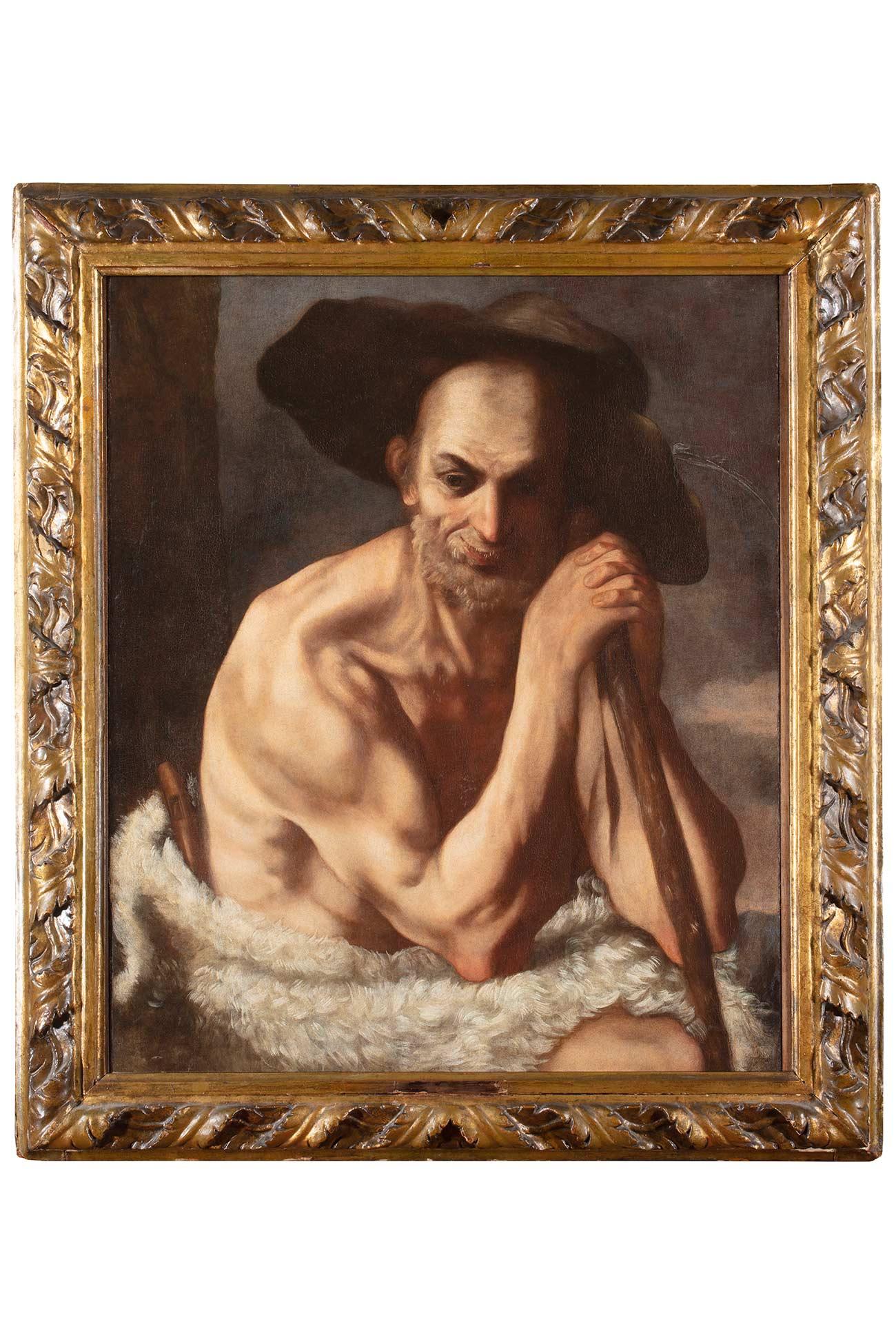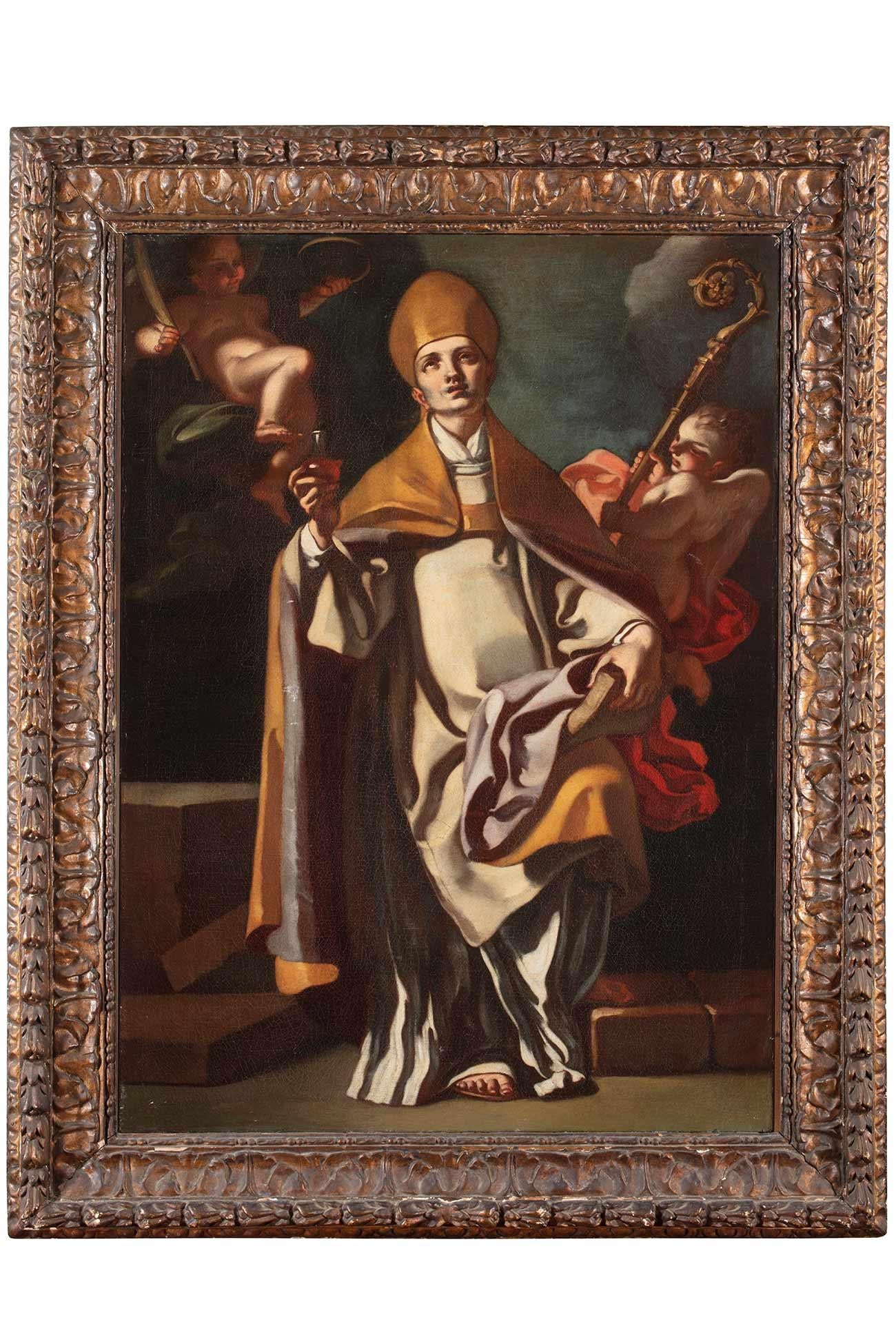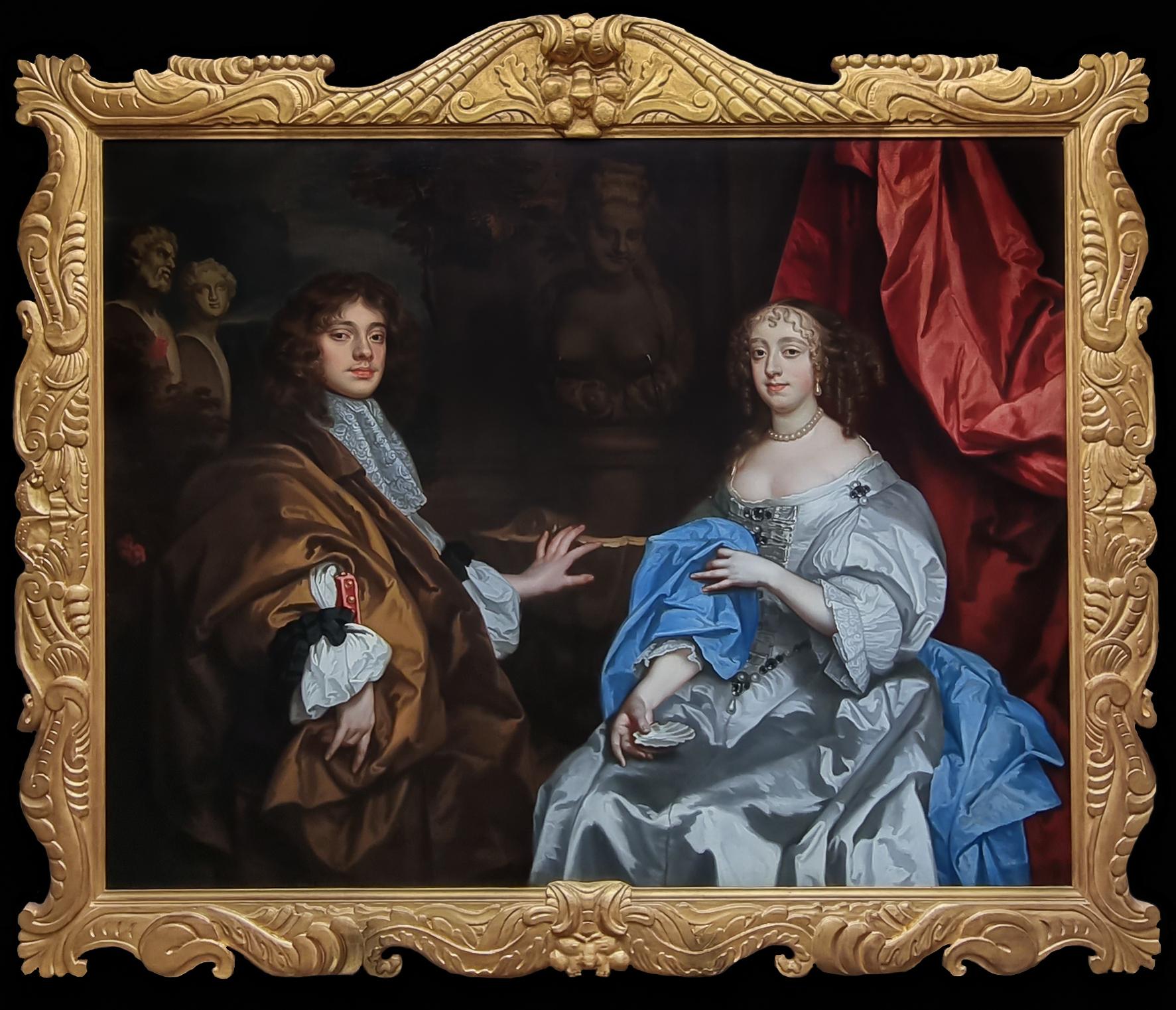Items Similar to Portrait of a Lady, Katherine St Aubyn, Godolphin, Cornelius Johnson, Oil canvas
Want more images or videos?
Request additional images or videos from the seller
1 of 13
Portrait of a Lady, Katherine St Aubyn, Godolphin, Cornelius Johnson, Oil canvascirca 1637
circa 1637
About the Item
Titan Fine Art are pleased to present this charming bust-length portrait, which is a good example of the style of portrait painted in England in the second quarter of the seventeenth century. The attire consists of the finest silks, and the full billowing sleeves, bows, and hairstyle help in dating this portrait to circa 1637. The accessory par excellence – pearls – are worn as a necklace and were a very popular accessory. The artist makes no attempt to obey the rules of Baroque and instead sensitively depicts in complete honesty his sitter against a plain wall, and without distracting backdrops and flowing draperies – this work is very redolent of the sumptuous half-length female portraits that Cornelius Johnson painted for members of the court and gentry during the 1630s.
The sitter is Katherine St Aubyn, born Katherine Godolphin (1620-1662). The Godolphin’s are an ancient Cornish family (originally “Godolghan” which in Cornish means “White Eagle”) who were established at their family seat, Godolphin Manor, since the time of the Norman Conquest in the year 1,000. The Manor descended from the first known lord, John de Godolphin, to Tudors times, from father to son, barring once in the 14th century.
Katherine was born in September 1620 and was the youngest daughter of Francis Godolphin (1589-1652), of Treveneage in Cornwall, and his wife Ann Carew. She married into another ancient family - the St. Aubyn’s, whose ancestors can be traced back in Devonshire to the 14th century. Her husband John St Aubyn (c.1613–1684) of Clowance and St Michael’s Mount, was a member of parliament and during the English Civil war he served as a colonel in the parliamentary army - unlike the senior branches of the Godolphin’s, who served as Royalists. The couple had six sons and four daughters. Katherine was buried at Crowan on 16 Mar 1662 when she was only 41 years of age. Her husband was also buried there, 22 years later.
The couple married on 29th March 1637. This date coincides with the date the portrait was painted, given that the attire and hairstyle were fashionable in 1637. It is very likely that the portrait was commissioned to mark this important event in the sitter’s life, as was customary at the time. Furthermore, the figure is turned toward the viewer’s left, which was usually the manner in which a married woman would be depicted in English portraiture at the time (the pendant portrait, her husband, would have been turned toward the viewer’s right).
Cornelius Johnson (1593-1664) through merit and splendid achievement, can be placed within the first rank of England’s portrait painters of the generation before Van Dyke. Cornelius Johnson was a painter beautifully sensitive to individual character and his careful and faithful depictions of clothing afford a priceless resource to historians – he was the first British-born portrait painter (born in London) to regularly sign and date his work. His precise, meticulous, and dignified portraits perfectly reflect the spirit of the arts in England at the time. So great a painter, he was sworn in as the King’s own painter in 1632. His work is found in most pubic collections in Britain and in many private collections – seen on the walls in many British country houses, in the possession of descendants of the original sitters.
Johnson was born into a Flemish/German immigrant family in 1593 in London. He is thought to have begun his independent practice in London, in about 1619. Where he trained it is not fully known as records are scant, but it is thought to be in Amsterdam. In addition, he may also have received some training in the London studio of Marcus Gheeraerts II (1561/2-1636), who was the official portraitist of James I’s queen, Anne of Denmark. As a result, even Johnson’s earliest pictures display a level of continental sophistication not often seen in the works of English Jacobean artists. And in a society that relished ‘conspicuous consumption’, and thus the display of expensive costumes, Johnson’s Dutch realism and sense of likeness proved popular. He became extremely prolific and he painted elegant images of the King, the Queen, and the whole court, many leading lawyers and public servants, but also a regional clientele away from the court primarily in Kent.
In 1632, the same year Van Dyck arrived in England, Johnson was appointed one of King Charles I’s painters. In late 1634 Johnson is recorded to have been living in London. By some accounts, Johnson moved to Kent around 1636 but this is not known for certain. What is certain is that from about the early 1630s onwards his clients included many sitters from a group of families living around Canterbury, Kent.
In 1643, just prior to the outbreak of the Civil Wars in Britain, Johnson and his family left for Holland where he worked in more than one city and was leading portrait painter in Utrecht, where he remained until his death. His only surviving son, called Cornelius, was born in London in 1634. He too was a painter and assisted his father.
There are three old labels on verso (see photos); two refer to London storage firms and the surname ‘Scrimageour’ (which may be J & A Scrimgeour, insurance brokers located at 3 Lothbury, London EC2).
Provenance: Private UK collection
Measurements: Height 82cm, Width 71cm framed (Height 32”, Width 28” framed)
- Creation Year:circa 1637
- Dimensions:Height: 32.29 in (82 cm)Width: 27.96 in (71 cm)Depth: 1.58 in (4 cm)
- Medium:
- Movement & Style:
- Circle Of:Cornelius Johnson (1593 - 1661, British)
- Period:
- Condition:This painting has passed a strict quality and condition assessment by a professional conservator prior to going on sale. It can be hung and enjoyed immediately.
- Gallery Location:London, GB
- Reference Number:1stDibs: LU1199110599512
About the Seller
5.0
Platinum Seller
These expertly vetted sellers are 1stDibs' most experienced sellers and are rated highest by our customers.
Established in 1998
1stDibs seller since 2019
31 sales on 1stDibs
Typical response time: <1 hour
- ShippingRetrieving quote...Ships From: London, United Kingdom
- Return PolicyA return for this item may be initiated within 14 days of delivery.
More From This SellerView All
- Portrait of Abigail, Countess of Kinnoull, Signed Dated Godfrey Kneller PaintingBy Kneller GodfreyLocated in London, GBPresented by Titan Fine Art, this elegant and beautiful portrait depicts Abigail Hay, Lady Dupplin, Countess of Kinnoull; it is an excellent example of English portraiture from the f...Category
18th Century Old Masters Portrait Paintings
MaterialsCanvas, Oil
- Double Portrait of Sir John Rivers 3rd Baronet of Chafford, and Lady Anne RiversLocated in London, GBThis magnificent grand-scale work, offered by Titan Fine Art, formed part of a collection of family pictures and heirlooms of the Rivers Baronets and their descendants for over 325 years, before it was dispersed by the last in the line in 1988. The work was painted by the most technically proficient painter in England after the death of Van Dyck, and the dominant court painter to Charles II and James, Duke of York, Sir Peter Lely. It is no surprise that for years Lely had no serious rivals, was enormously influential and successful, and one of the country’s most important painters – and his work influenced countless artists over generations. The exquisite carved and gilded auricular frame is an astounding work of art in itself. The sitters in this exquisite double portrait are Sir John Rivers, who succeeded as the 3rd Baronet Chafford in 1657 (c.1638 - c. 1679), and his wife, Lady Anne Hewitt (c.1640-c.1689). They are seated in an outdoor setting beside a fountain modelled as a female figure with water issuing into a scallop-shell. The water, the elaborate sculpted fountain with its scallop-edged bowl, and the open shell in her hand are symbols of fertility - as such they make an appropriate allusion to Lady Anne’s potential as wife and mother, recalling Proverbs, chapter 5, verse 18: “Let thye fountain be blessed, and rejoice in the wife of thye youth”. This reference was realised, as Sir John and Lady Anne produced at least six children; their son George (1665-1734) became 4th Baronet of Chafford. The composition, thus, represents a celebration of marriage and was likely commissioned around the time of the betrothal (the marriage took place 26th Feb 1662 or 1663). The statues in the left margin are 'Youth and 'Old Age' and are a typical form of Memento Mori reminding virile young man that even they will lose their youth and grow old. The Rivers family, originally of Kent, traces its history to Sir Bartholomew Rivers, in the reign of Edward IV. The family included several prominent members including several knights, a Commander in the King's Army, a steward of a ducal estate, a Lord-Mayor of London, and an M.P. John Rivers (c.1659-c.1651) was made 1st Baronet of Chafford in 1622 by King James I. The Chafford estate was the family seat and it remained so until the early 1700s with the death of Sir George Rivers, 4th Baronet (1665–1734), whose sons had all died. The Chafford estate was left to his daughters while the baronetcy passed to nephew John Rivers, 5th Baronet (c. 1718–1743), and then Sir John’s brother, Sir Peter Rivers-Gay, 6th Baronet (c. 1721–1790). Upon Sir Peter Rivers Gay's death the estate passed to his eldest son, Sir Thomas Rivers Gay, 7th Baronet (c. 1770–1805). Sir Thomas, dying in 1805 with no children, bequeathed the estate to his mother Dame Martha Rivers Gay, who managed the estate until 1834 when she settled it on the then Sir Henry Rivers, 9th Baronet (c. 1779–1851) her younger son, before dying shortly thereafter in 1835. Sir Henry had married in 1812 to Charlotte Eales, with whom he had 6 sons and 8 daughters. Upon his death in 1851 the estate passed to his eldest surviving son Sir James Francis Rivers, 10th Baronet (1822–1869). Sir James married Catherine Eastcott in 1867 but died childless in 1869, and the estate passed to his only surviving brother Sir Henry Chandos Rivers, 11th Baronet (1834–1870) but he died a year later in 1870 also childless; with no male heir the Baronetcy was therefore extinguished. The estate was bequeathed, in trust, by Sir Henry Chandos Rivers to Thomas Frederick Inman, a solicitor of Bath, who then managed the estate as a trustee on behalf of Sir Henry Chandos Rivers' sister Katherine Rivers (c.1826-1895). It then passed to Katherine River’s daughter, Katherine Wall (born c.1855), who had also inherited Worthy Park House from her father, George Alfred Ellis Wall (1825-1875). Until 1958 our portrait is known to have hung at Worthy Park House. Upon Katherine Wall’s death, the Rivers estate passed to her daughter, Katherine Eleonora Rivers Fryer (1889-1963), who married Colonel James Alexander Butchart 1877-1853. In 1958 the family sold Worthy Park House but our portrait was loaned to Southampton Museum and Art Gallery. After the death of Katherine and Colonel James, the estate was left to their only son, Charles Bruce Rivers Butchart (1917-2005) and upon Charles’ retirement to a nursing home in 1988, and without heirs, our portrait, along with the residual assets of the Rivers estate were sold, thus ending over 325 years of continual family ownership. Lady Anne Rivers is thought to have been born circa 1640. She was the fourth child of the second marriage of Sir Thomas Hewitt (or Hewett) (1606-1662), 1st Baronet of Pishobury, Herts, and his wife Margaret Lytton (died 1689). Sir Thomas was an English landowner and M.P. for Windsor and upon the English Restoration...Category
17th Century Old Masters Portrait Paintings
MaterialsCanvas, Oil
- Portrait of Lady Anne Tipping née Cheke c.1705, English Aristocratic CollectionBy Kneller GodfreyLocated in London, GBTitan Fine Art present this exquisite portrait, that formed part of a historic collection of an English aristocratic family, Lord and Lady Sandys at their magnificent baroque and Reg...Category
18th Century Old Masters Portrait Paintings
MaterialsCanvas, Oil
- Portrait of a Gentleman in Scarlet Robe Holding Flowers c.1675, Oil on canvasLocated in London, GBTitan Fine Art present this striking portrait, which was painted by one of the most talented artists working in England during the last half of the 17th century, John Greenhill. Gre...Category
17th Century Old Masters Portrait Paintings
MaterialsCanvas, Oil
- Portrait of a Lady in Silver Silk Dress & Pearls c.1660, Oil on canvas paintingLocated in London, GBThis exquisite work is an accomplished example of the type of portrait in vogue in England during the third quarter of the 17th century. There was a large demand for paintings in England and the demand for portraits was greatest. Many artists worked in this lucrative field, even artists who initially trained in the more respected field of history painting, such as Peter Lely, turned their attention to portraiture to meet this demand. Moreover, it was not uncommon for the British, even for men, to present a gift of one’s portrait to a friend - portraits were first and foremost a memento. Woman at court often vied with one another in displays of rich and fashionable clothing. The drapery was either painted from the customer’s own clothes or was perhaps a creation using fabrics loosely tacked together in the studio. This was a common practice of Lely and his studio props included swathes of fabric and pieces of cloth. The sitter’s sumptuous attire and gauze scarf, fastened by a large diamond brooch, is of the finest material and is representative of wealth. Pearls were an obligatory accompaniment since at least the 1630s and they are worn in abundance – in her hair, on her attire, as a necklace, and as pear-shaped earrings called unions d’excellence, reflecting the difficulty of finding perfectly matched pearls of such large size. They could range up to 20 millimetres in diameter. Her hairstyle help date the painting to the early 1660’s. Peter Lely, the son of a Dutch...Category
17th Century Old Masters Portrait Paintings
MaterialsCanvas, Oil
- Portrait of a Lady, Maria Virginia Borghese Chigi Princess Farnese Oil on canvasLocated in London, GBThis exquisite portrait, presented by Titan Fine Art, belongs to a type of portrait known as ‘Les Belle Romanes’. Voet is perhaps best remembered for his series of them – a great set of portraits...Category
17th Century Old Masters Portrait Paintings
MaterialsCanvas, Oil
You May Also Like
- 15th Century by Circle of Nicolò Zafuri Madonna with Child Oil on CanvasLocated in Milano, LombardiaNicolò Zafuri (circle of) (documented in Candia between 1487 and 1500, died before 10 July 1501) Madonna with Child oil on panel, cm. 49 x 40 This precious panel depicting the Mado...Category
15th Century and Earlier Old Masters Portrait Paintings
MaterialsCotton Canvas, Cotton, Oil
- 17th Century by Cristoforo Serra Portrait of a Shepherd Oil on CanvasLocated in Milano, LombardiaCristoforo Serra (Cesena 1600 - Cesena 1689) Portrait of a Shepherd Oil on canvas, cm. 92 x 75 - with frame cm. 106,5 x 94,5 Antique giltwood cassetta frame, carved and sculpted Pu...Category
Early 17th Century Old Masters Portrait Paintings
MaterialsCanvas, Cotton Canvas, Oil
- 18th Century by Evangelista Schiano Saint Gennaro Oil on CanvasLocated in Milano, LombardiaEvangelista Schiano (attr.) (active in the 18th century) Saint Gennaro Oil on canvas, cm. 102 x 74 - with frame 126,5 x 100 cm. 19th century carved, sculpted and gilded wooden frame ...Category
Mid-18th Century Old Masters Portrait Paintings
MaterialsCanvas, Cotton Canvas, Oil
- 16th Century By Circle of Giovan Battista Moroni Portrait of Woman Oil on CanvasLocated in Milano, LombardiaGiovan Battista Moroni (circle of) (Albino, 1520 – 1580 ca.) Portrait of a woman Oil on canvas, cm. 46 x 40 - with frame cm. 55,5 x 50,5 Antique shaped and gilded wooden cassetta frame. Publications: unpublished. The present portrait shows an adult woman, no longer young, as can be seen from her slightly blistered cheeks, but not elderly either. The suspicious and veiledly inquisitive gaze is well matched by the elegance of her extremely fashionable black clothes...Category
16th Century Old Masters Portrait Paintings
MaterialsCanvas, Cotton Canvas, Oil
- 19th century portrait painted in St Petersburg in 1819Located in London, GBSigned, inscribed and dated, lower right: 'Geo Dawe RA St Petersburgh 1819', also signed with initials, lower centre: 'G D RA'; and signed and inscribed verso: 'Geo Dawe RA Pinxit 1819 St Petersburgh'; Also inscribed on the stretcher by Cornelius Varley with varnishing instructions. Collections: Private collection, UK, 2010 Literature: Galina Andreeva Geniuses of War, Weal and Beauty: George Dawe...Category
19th Century Old Masters Portrait Paintings
MaterialsOil, Canvas
- 17th Century by Giuseppe Assereto Portrait of an Elderly Woman Oil on CanvasBy Giuseppe AsseretoLocated in Milano, LombardiaGiuseppe Assereto (Genova - 1626 ca – Genova 1656/57) Portrait of an elderly woman, possible portrait of Maddalena Massone, wife of Gioacchino Assereto Oil on canvas, cm. 65,5 x 51,5...Category
Early 17th Century Old Masters Portrait Paintings
MaterialsCanvas, Oil
Recently Viewed
View AllMore Ways To Browse
Old Woman Portrait
Portrait Of A Queen
Antique Portrait Studio
Oil Portrait Of A Lady
Antique Portrait Of A Lady
Antique German Portrait
Antique Dutch Portraits
Portrait Lady Oil Canvas
Portrait Woman German
Portrait Lady Oil On Canvas
Old Master Paintings War
Dutch Master Portrait
Painted Portrait Woman White
Portrait Of A Lady Oil On Canvas
Old Woman Portrait Painting
Old English Portraits
Flemish Portrait
Portrait Of Charles I





